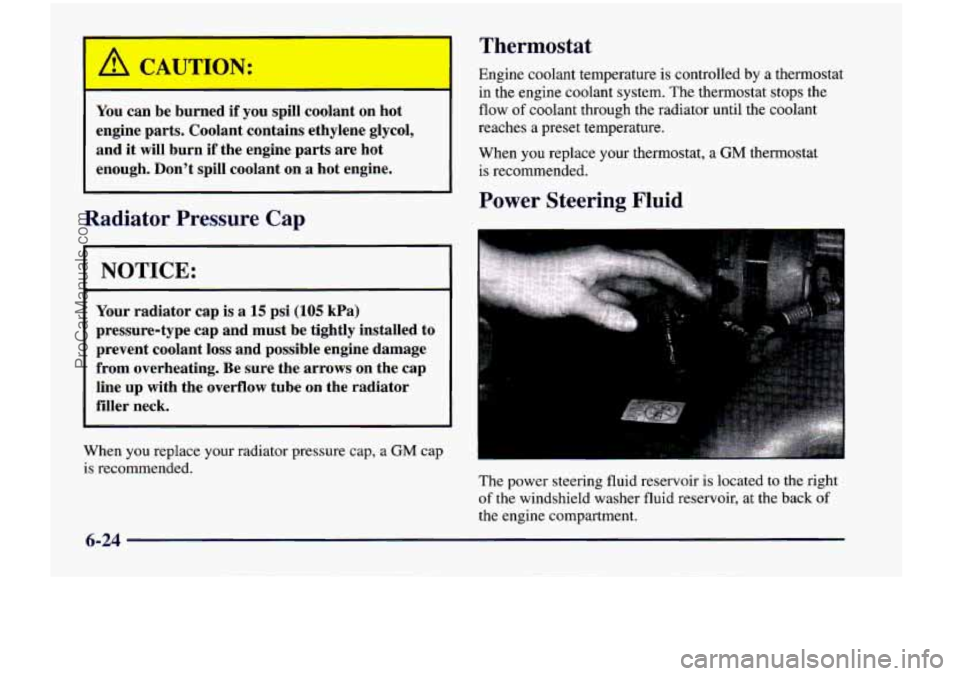Page 313 of 474
When you decide it’s safe to lift the hood, here’s what
rou’ll see:
i. Radiator Pressure Cap
3. Electric Engine Fans
3. Coolant Recovery Tank
A CAUTION:
I
An electric engine cooling fan under the hood can
start
up even when the engine is not running and
can injure you. Keep hands, clothing and tools
away from any underhood electric fan.
If the coolant inside the coolant recovery tank is boiling,
don’t
do anything else until it cools down.
5-16
ProCarManuals.com
Page 317 of 474
A CAUTION:
Steam and scalding liquids from a hot cooling
system can blow out and burn you badly. They
are under pressure, and
if you turn the radiator
pressure cap
-- even a little -- they can come out
at high speed. Never turn the cap when the
cooling system, including the radiator pressure
cap, is hot. Wait for the cooling system and the
radiator pressure cap to cool
if you ever have to
turn the pressure cap.
5-20
ProCarManuals.com
Page 318 of 474
How to Add Coolant to the Radiator
2. Then keep turning the pressure cap, but now push
down as you turn
it. Remove the pressure cap.
1.
You can remove the radiator pressure cap when the
cooling system, including the radiator pressure cap and
upper radiator hose, is
no longer hot. Turn the pressure
cap slowly counterclockwise until it first stops. (Don’t
press down while
turning the pressure cap.)
If you hear a hiss, wait for that to stop. A hiss means
there is still some pressure left.
ii
5-21
ProCarManuals.com
Page 336 of 474

Section 6 Service and Appearance Care
Here you will find information about the care of your vehicle. This section begins with service and fuel information,
and then it shows how to check important fluid and lubricant levels. There is also technical information about your
vehicle, and
a part devoted to its appearance care.
6- 18
6-2 1
6-24
6-25
6-26
6-30
6-3
1
6-39 6-2
Service
6-3 Fuel
6-7 Filling a Portable Fuel Container
6-
8 Checking Things Under the Hood
6-11 Engine Oil
6-15 Air Cleaner
6-16 Passenger Compartment Air Filter
Replacement
Automatic Transaxle Fluid
Engine Coolant
Radiator Pressure Cap
Windshield Washer Fluid
Brakes
Battery
Bulb Replacement
Windshield Wiper Blade Replacement 6-40
6-48
6-48
6-52
6-54
6-54
6-55
6-56
6-57
6-64
6-65
6-65
6-66
6-66
6-66 Tires
Appearance
Care
Cleaning the Inside of Your Vehicle
Cleaning the Outside of Your Vehicle
Underbody Maintenance Chemical Paint Spotting
Appearance Care Materials Chart
Vehicle Identification Number (VIN)
Electrical System
Replacement Bulbs
Capacities and Specifications
Engine Specifications
Vehicle Dimensions
Normal Maintenance Replacement Parts
Air Conditioning Refrigerants
ProCarManuals.com
Page 345 of 474
When you lift the hood, you'll see these items:
rn
A. Underhood Fuse and D. Radiator Pressure Cap H. Transaxle Fluid Dipstick
B. Remote Positive (+) Terminal
C. Windshield Washer
Fluid Reservoir Relay Center
E. Power Steering Fluid Reservoir I. Brake Master Cylinder
E Engine Oil Fill Location J. Air Cleaner
G. Engine Oil Dipstick K. Engine Coolant Reservoir
6-10
ProCarManuals.com
Page 358 of 474
Checking Coolant If this light comes on, it
The engine coolant reservoir
is located on the driver’s
side
of the vehicle, above the air cleaner. means you’re low
on
engine coolant.
Adding Coolant
If you need more coolant, add the proper DEX-COOL@
coolant mixture
at the coolant recovery tank.
When your engine is cold, the coolant level should
be at FULL COLD, or a little higher. When your engine is warm, the level should
be above the FULL
COLD mark, or a little higher.
Add coolant mixture at the recovery tank, but be careful
not to spill it. ’hrning the radiator pressure cap
when the
engine and radiator
are hot can allow steam and
scalding liquids to blow out and burn you badly.
With the coolant recovery tank, you will almost
never have to add coolant
at the radiator.
Never turn the radiator pressure cap
-- even a
little -- when the engine and radiator are hot.
6-23
ProCarManuals.com
Page 359 of 474

Thermostat
Engine coolant temperature is controlled by a thermostat
in the engine coolant system. The thermostat stops the
flow
of coolant through the radiator until the coolant
reaches a preset temperature.
You
can be burned if you spill coolant on hot
engine parts, Coolant contains ethylene glycol,
and
it will burn if the engine parts are hot
enough. Don't spill coolant on
a hot engine.
Radiator I ressure Cap
NOTICE:
Your radiator cap is a 15 psi (105 kPa)
pressure-type cap and must be tightly installed to
prevent coolant
loss and possible engine damage
from overheating. Be sure the arrows on the cap
line up with the overflow tube on the radiator
filler neck.
When you replace your radiator pressure cap,
a GM cap
is recommended. When you replace your thermostat, a
GM thermostat
is recommended.
Power
Steering Fluid
'l'kv Gower steering fluid reservoir is located to the right
of the windshield washer fluid reservoir, at the back of
the engine compartment.
ProCarManuals.com
Page 423 of 474
I Short Trip/City Maintenance Schedule I
150,000 Miles (240 000 km)
0 Drain, flush and refill cooling system (or every 60 months since last service,
whichever occurs first). See “Engine Coolant” in the Index for what to use.
Inspect hoses. Clean radiator, condenser, pressure cap and neck. Pressure test
cooling system and pressure cap.
An Emission Control Sewice.
MILEAGE ACTUAL I SERVICED BY:
7-20
ProCarManuals.com